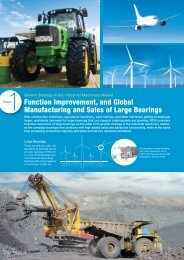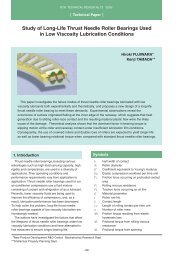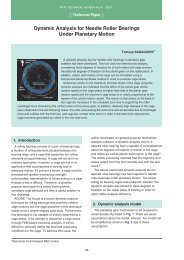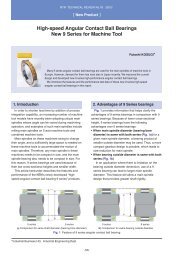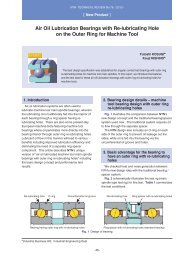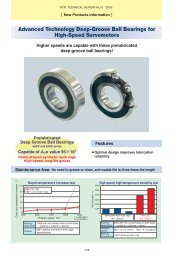Special Issue; Products for Industrial Machinery - NTN
Special Issue; Products for Industrial Machinery - NTN
Special Issue; Products for Industrial Machinery - NTN
You also want an ePaper? Increase the reach of your titles
YUMPU automatically turns print PDFs into web optimized ePapers that Google loves.
High-Speed Tapered Roller Bearing <strong>for</strong> Machine Tool Main Spindles<br />
The resultant measurements are graphically plotted in<br />
Fig. 4.<br />
In Fig. 4 the difference between the total torque and<br />
rib torque equals the sum of 1), 3) and 4) described<br />
above. Since the effect of 4) is sufficiently small in the<br />
relatively low speed range of less than 4000 min -1 and<br />
1) is predominant over 3) with roller bearings, 3) the<br />
difference between the total torque and rib torque is<br />
essentially equivalent to 1), that is, the EHL rolling<br />
viscosity friction on the raceway surface. As can be<br />
understood from expression (1), when there is no<br />
effect of starvation and heat generation, the rolling<br />
viscosity resistance increases in proportion of the<br />
0.65th power of the rotation speed. However, the total<br />
torque starts to decrease at around 300 min -1 when<br />
the effect of heat generation seems to be minimal.<br />
This appears to be due to the significant effect of<br />
starvation.<br />
Also, it will be understood that as the amount of oil<br />
is reduced, the effect of starvation is more apparent<br />
and the rolling viscosity resistance decreases. At the<br />
Bearing<br />
Table 1 Specifications of torque test bearing<br />
and test conditions<br />
Test<br />
conditions<br />
Description: 32020XUP4<br />
Size: ID 100 x OD 150 x 32 mm total width<br />
Contact angle: 17˚<br />
Rollers: 29 steel rollers<br />
Cage: Pressed steel cage, rolling element guide<br />
Bearing load: 1 kN axial load<br />
Bearing lubrication: Air-oil<br />
Oil supply from both sides of bearing<br />
Nozzle dia. 1.21 (per side)<br />
ISO VG32 oil used<br />
Jacket cooling: None<br />
same time, because the rib is under fluid lubrication<br />
conditions, the rib torque is proportional to the bearing<br />
speed, and increases with a decreased amount of<br />
lubricating oil. This fact further supports the analysis<br />
results described above.<br />
In summary, in order <strong>for</strong> a tapered roller bearing to<br />
be able to run at a higher speed, it is necessary to<br />
invent a mechanism that minimizes the supply of<br />
lubricating oil to the raceway surface while supplying<br />
plenty of lubricating oil to the rib.<br />
3. Structure and Per<strong>for</strong>mance of the<br />
Authors’ Bearing<br />
3.1 Basic structure<br />
Based on the approach described above, the<br />
authors developed and evaluated various prototype<br />
bearings with unique lubrication schemes and internal<br />
constructions. Consequently, the authors finally<br />
developed the unique tapered roller bearing with the<br />
construction illustrated in Fig. 5. Now, referring to Fig.<br />
5, let us describe its features. First, the authors’<br />
tapered roller bearing lacks an ordinary inner-ring rib,<br />
and instead, the rib is situated on the outer-ring side.<br />
This arrangement prevents the lubricating oil from<br />
flying away due to the centrifugal <strong>for</strong>ce of the rotating<br />
inner-ring as well as resultant insufficiency in the<br />
amount of lubricating oil. At the same time, to<br />
effectively lubricate the rib, multiple direct-injection<br />
nozzles are provided on the rib surface that supply airoil<br />
lubricating oil. Incidentally, the usual oil supply from<br />
the back side is not provided. Instead, the lubricating<br />
oil from the direct-injection nozzles is directed to the<br />
raceway surface through the spaces between the<br />
rollers. Because the pockets and rollers interfere with<br />
each other at higher speeds on roller guiding cages<br />
such as the standard type, the authors have adopted<br />
Torque Nm<br />
1.8<br />
1.6<br />
1.4<br />
1.2<br />
1.0<br />
0.8<br />
0.6<br />
0.4<br />
0.2<br />
0<br />
0<br />
21.6cc/h total torque<br />
7.2cc/h total torque<br />
3.6cc/h total torque<br />
1.8cc/h total torque<br />
0.9cc/h total torque<br />
Total torque<br />
Rib torque<br />
21.6cc/h rib torque<br />
7.2cc/h rib torque<br />
3.6cc/h rib torque<br />
1.8cc/h rib torque<br />
0.9cc/h rib torque<br />
Decrease in<br />
oil amount<br />
Decrease in<br />
oil amount<br />
500 1000 1500 2000 2500 3000 3500 4000<br />
Running speed min -1<br />
Fig. 4 Measured torque values of standard tapered roller<br />
bearing 32020<br />
Enlarged view<br />
Outer-ring spacer<br />
guided resin cage<br />
Direct-injection<br />
nozzle<br />
Rib<br />
Ceramic roller<br />
Fig. 5 Section view of developed tapered roller bearing<br />
-19-



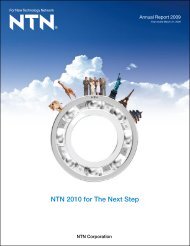
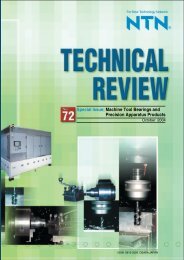
![[New Product] Unit Products for Office Equipment - NTN](https://img.yumpu.com/27154451/1/184x260/new-product-unit-products-for-office-equipment-ntn.jpg?quality=85)
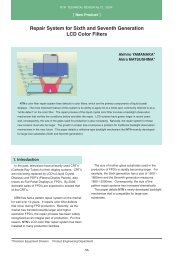
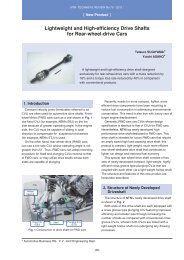
![[New Product] Development of Oil-impregnated Sintered ... - NTN](https://img.yumpu.com/27154427/1/184x260/new-product-development-of-oil-impregnated-sintered-ntn.jpg?quality=85)

